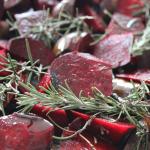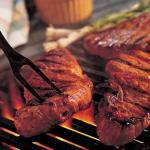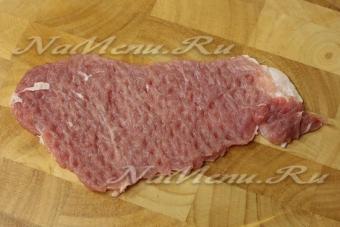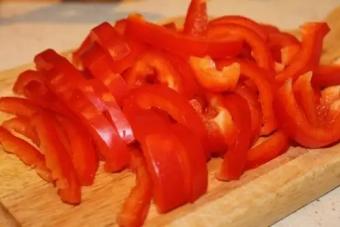Deciphering grades of steels and cast irons? Sometimes this question seems simply unsolvable. Even from the university bench, when materials science is taught, this issue is considered somehow crumpled and not always clear, although if you understand everything is quite simple.
Today I started looking for the most complete and at the same time the most concise material on deciphering grades of steels and cast irons, the Internet is full of repetitive information from site to site. This resource answered the above question most fully, and the one below is most concise and accessible. methodical work(Unfortunately I didn't find the author)
Deciphering the designations of steel and cast iron grades
Target:
1. The study of the principles of designation of grades of steels and cast irons
The task
1. Familiarize yourself with the method of marking various grades of steels and cast irons according to the guidelines
2. Give a breakdown of the grades of steels and cast irons on the card of an individual task
Information from the theory
CAST IRON
Cast iron- an iron-carbon alloy containing more than 2.14% carbon, permanent impurities.They are not very plastic, they are not rolled and are not forged. Cast irons have a low melting point and good casting properties. Due to this, castings of much more complex shapes can be made from cast irons than from steels.
Types of cast iron:
Depending on what form carbon is present in the alloys, there are white, gray, malleable and ductile cast irons.
White cast iron
It got its name from the type of fracture, which has a matte white color. All carbon in this cast iron is in a bound state in the form of cementite. White cast irons have a high hardness (HB 450-550) and, as a result, they are very brittle and are not used for the manufacture of machine parts.
The high hardness of white cast iron ensures its wear resistance, including when exposed to aggressive media. This property is taken into account in the manufacture of piston rings from it. However, white cast iron is used mainly for casting parts on malleable cast iron, so it is called pig iron.
Gray cast iron
In gray cast iron, carbon is in the form of lamellar graphite.
Gray cast irons are marked with a combination of the letters "C" - gray, "Ch" - cast iron and numbers that indicate the tensile strength in MPa.
Ductile iron
A distinctive feature of high-strength cast iron is its high mechanical properties, since the carbon structure in it is nodular graphite. This increases the strength of cast iron and makes it possible to obtain alloys with sufficiently high ductility and toughness.
The brand designation includes the letters "B" - high-strength, "Ch" - cast iron and numbers indicating the tensile strength in MPa.
malleable iron
Malleable cast irons are cast irons in which graphite has a flaky form. Despite their name, they are never forged. The configuration of a ductile iron part is determined by the shape of the casting. Malleable cast irons are marked with "K" - malleable, "Ch" - cast iron and numbers. The first group of numbers shows the tensile strength of cast iron, MPa: the second - relative elongation at break in%.
Cast irons with special properties
Depending on the purpose, wear-resistant, anti-friction, heat-resistant and corrosion-resistant cast irons are distinguished.
Wear-resistant (anti-friction) cast irons
Designated by a combination of letters ASF, ACHK, ACHV. The letters C, K, B denote the type of cast iron: gray, malleable, high-strength. The number indicates the number of cast iron. Chromium, nickel, copper, and titanium are used for alloying antifriction cast irons.
Heat-resistant and heat-resistant cast irons
Designated by a set of capital letters of the Russian alphabet and the letters following them. The letter "Ch" is cast iron.
The letter "Ш" standing at the end of the brand means the spherical shape of graphite. The remaining letters mean alloying elements, and the numbers following them correspond to their percentage in cast iron.
Heat-resistant cast irons are used for the manufacture of parts for contact devices of chemical equipment operating in gaseous media at a temperature of 900-11000 0 C.
Corrosion resistant cast irons
Corrosion-resistant cast irons are highly resistant to gas, air and alkaline environments. They are used for the manufacture of parts for friction units operating at elevated temperatures.1. СЧ15 - gray cast iron, tensile strength 150 MPa.
2. КЧ45-7 - malleable cast iron, tensile strength 450MPa, relative elongation 7%.
3. VCh70 - ductile iron, tensile strength 700 MPa
4. AChV - 2 - anti-friction high-strength cast iron, number 2.
5. ChN20D2KhSh - heat-resistant high-alloy cast iron containing nickel 20%, 2% copper, 1% chromium, the rest - iron, carbon, graphite shape - spherical
6. ChS17 - corrosion-resistant silicon cast iron containing 17% silicon, the rest is iron, carbon.
Become
Steel- an alloy of iron with carbon containing no more than 2.14% carbon, as well as a number of other elementsClassification
For a correct reading of the brand, it is necessary to take into account its place in the classification of steel according to chemical composition, purpose, quality, degree of deoxidation
- By chemical composition steels are divided into carbon and alloy steels.
- Steel as intended are divided into structural, tool and special-purpose steels with special properties.
- Steel by quality classify into steels of ordinary quality, high-quality, high-quality and extra high-quality.
- Classification according to the degree of deoxidation. According to the degree of deoxidation, steels are classified into calm, semi-quiet and boiling.
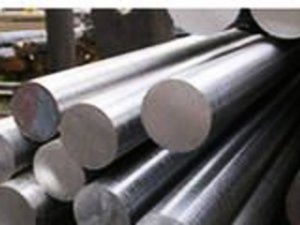
Structural steels- steels intended for the manufacture of various parts, components of mechanisms and structures.
Tool steels- steels used for the processing of materials by cutting or pressure, as well as for the manufacture of measuring tools
Special steels- these are high-alloyed (over 10%) steels with special properties - corrosion resistance, heat resistance, heat resistance, wear resistance, etc.
carbon steels
Carbon steels include steels that do not contain specially introduced alloying elements.
Structural carbon steels
Carbon steels of ordinary quality (steel with a sufficiently high content of harmful impurities S and P) are designated according to GOST 380-94.
These most widely used steels are supplied in the form of rolled products in a normalized state and are used in mechanical engineering, construction and other industries.
Carbon steels of ordinary quality are denoted by the letters St and numbers from 0 to 6. The numbers are the conditional brand number. The higher the number, the higher the carbon content, the higher the strength and the lower the ductility.
Before the symbol St, a group of guaranteed properties is indicated: A, B, C. If there is no indication of a group, then group A is assumed. For example, ST3; Bst4; VST2.
Ordinary quality steel is also produced with a high manganese content (0.8-1.1% Mn) / In this case, the letter G is added after the grade number. For example, BST3Gps.
After the steel grade number, the degree of deoxidation is indicated: kp - boiling, ps - semi-calm, cn - calm steel. For example, WST3ps.
Table 2. Structure of the designation of carbon steels
steel group | Designation | Steel number | Degree | |
kp, ps, sp |
||||
kp, ps, sp | ||||
kp, ps, sp | ||||
Table 3. The meaning of the letters and numbers used in the marking of steels of ordinary quality
Designation | Deciphering the designation |
A group of steels supplied with guaranteed mechanical properties. Usually, when designating steels, the letter A is omitted |
|
Steel group supplied with a guaranteed chemical composition |
|
Group of steels supplied with guaranteed chemical composition and mechanical properties |
|
Abbreviation for the term "steel" |
|
Conventional steel grades |
|
The presence of the letter G after the steel number means an increased content of manganese |
|
Steel "boiling", deoxidized only by ferromanganese |
|
Steel "semi-quiet", deoxidized with ferromanganese and aluminum |
|
The steel is "calm", that is, completely deoxidized. |
1. BST2kp - structural carbon steel of ordinary quality, group B, supplied with a guaranteed chemical composition, number 2, boiling.
2. ST5Gps - structural steel of ordinary quality, group supplied with guaranteed mechanical properties, number 5, manganese content up to 1%, semi-quiet.
3. VStZsp - structural carbon steel of ordinary quality, group B, supplied with a guaranteed chemical composition and mechanical properties, number 3, calm.
Designation of carbon quality structural steels
High-quality structural steel - steel with a noticeably lower content of sulfur, phosphorus and other harmful impurities. Designated according to GOST 1050-88.
Steel is marked with two-digit numbers, which indicate the carbon content in hundredths of a percent, and is supplied with guaranteed chemical composition and mechanical properties. According to the degree of deoxidation, steel is divided into boiling (kp), semi-calm (ps), calm (without indicating the index). The letter G in steel grades indicates an increased content of manganese (up to 1%).
Examples of designation and decoding:
1. Steel 05kp - low-carbon structural steel, high-quality, containing 0.05% carbon, boiling.
2. Steel 25 - low-carbon structural steel, of high quality, containing 0.25% carbon, calm.
3. Steel 60G - medium-carbon structural steel, of high quality, containing 0.6% carbon, 1% arganese, calm.
Automatic steel. Designation of automatic steels
According to GOST 1414-75, these steels are marked with the letter A and numbers showing the average carbon content in hundredths of a percent.
The following grades of automatic steel are used: A12, A20, AZO, A40G. Non-critical parts are prepared from A12 steel, more critical parts operating at significant stresses and high pressures are prepared from steel of other grades. The assortment of free-cutting steel provides for the production of long products in the form of bars of round, square and hexagonal sections. These steels are not used for the manufacture of welded structures.
Boiler steels. Sheet steel for boilers and pressure vessels is used for the manufacture of steam boilers, ship furnaces, combustion chambers and other parts. They must operate at variable pressures and temperatures up to 450 "C. In addition, boiler steel must be well welded. To obtain such properties, a technological additive (titanium) is introduced into carbon steel and it is additionally deoxidized with aluminum. The following grades of carbon boiler steel are produced 12K, 15K , 16K, 18K.20K.22Kc with carbon content from 0.08 to 0.28% These steels are supplied in the form of sheets with a thickness of up to 200 mm and forgings in the condition after normalization and tempering.
Examples of designation and decoding:
AS12KhN - automatic steel alloyed, low-carbon, containing 0.12% carbon, 1% chromium and nickel.Tool carbon steels
Designation of tool carbon steels
Tool carbon steels are marked in accordance with GOST 1435-90.
Tool carbon steels are produced in the following grades: U7.U8GA.U8G, U9, U 10, U 11, U 12 and U 13. The numbers indicate the carbon content in tenths of a percent. The letter G after the number means that the steel has a high manganese content. The grade of high quality carbon tool steel has the letter A.
Examples of designation and decoding
1. U12 - high-quality tool steel, containing 1.2% carbon.
2. U8GA - tool steel, high carbon, containing 0.8% carbon, 1% manganese, high quality
3. U9A - tool steel, high carbon, containing 0.9% carbon, high quality.
Alloy steels
Alloy steel is called steel with one or more alloying elements specially introduced.
Designation of alloy steels
Alloy steels are marked with a combination of numbers and capital letters of the alphabet. The designation does not contain the word "steel" or the symbol "St". For example, 40X, 38XM10A, 20X13. The first two digits indicate the carbon content in hundredths of a percent. The following letters are the element's abbreviation. The numbers after the letters indicate the content of this element in whole percent. If there is no number behind the letter, then the content of this element is up to 1%.
Table 4. - Designation of brand elements
For the manufacture of measuring instruments, X, CVG are used. Steels for dies: 9X, X12M, 3X2N8F.
Steels for percussion instruments: 4XC, 5XV2S.
Designation of high speed steels
All high speed steels are high alloyed. These are steels for equipping the working part of cutters, cutters, drills, etc.
The marking of high speed steels always begins with the letter P and a number indicating the percentage of tungsten. The most common brands are P9, P18, P12.
Alloy steels with special properties:
1. Corrosion resistant steels. Corrosion-resistant (or stainless) is steel that has high chemical resistance in aggressive environments. Corrosion-resistant steels are obtained by alloying low- and medium-carbon steels with chromium, nickel, titanium, aluminum, and manganese. Anticorrosion properties are imparted to steels by introducing a large amount of chromium or chromium and nickel into them. The most widespread are chromium and chromium-nickel steels. For example, chromium steels 95X18, 30X13, 08X17T. Chromium-nickel stainless steels have greater corrosion resistance than chromium steels, have increased strength and good workability in terms of pressure treatment. For example, 12X18H10T, 08X10H20T2.
2. Heat-resistante are resistant to chemical destruction in gaseous media, operating in a lightly loaded state
3. Heat resistant steels - these are steels capable of withstanding mechanical loads without significant deformations at high temperatures. Heat-resistant steels include chromium, silicon, molybdenum, nickel, etc.
For example, 40X10S2M, 11X11H2V2MF.
4. Wear-resistant steels with increased wear resistance: ball-bearing, graphitized and high-manganese. Features of the designation of bearing steels.
The marking begins with the letter W, the number after the letter X shows the chromium content in tenths of a percent. For example, ШХ9, ШХ15ГС.
Examples of designation and decoding
1. 40KhGTR - structural steel, alloyed, of high quality, containing 0.4% carbon and 1% chromium, manganese, titanium, boron, the rest is iron and impurities;
2. 38X2MYUA - structural steel, alloyed, high quality, containing 0.38% carbon, 2% chromium, 1% molybdenum, aluminum, the rest is iron and impurities;
3. KhVG - structural steel, alloyed, of high quality, containing 1% carbon and 1% chromium, manganese, the rest is iron and impurities;
4. ШХ15 - high-quality bearing steel, tool, containing 1% carbon, 1.5% chromium, the rest is iron;
5. R10K5F5 - high-speed, high-quality tool steel, containing 1% carbon, 10% tungsten, 5% cobalt, 5% vanadium, the rest is iron.
The leading place among all metallic materials used in mechanical engineering, instrument making, construction and many other areas is occupied by steels. They have valuable technological characteristics and are widely in demand due to their mechanical properties and physicochemical parameters.
Steels have an advantage over a large number of other materials, not only due to the complex of their technological and structural characteristics, but also due to their affordable cost.
Steel production technologies are constantly being improved, it is not only about improving quality. There are new brands with special sets of required characteristics.
The characteristics of each particular steel depend on its classification and the set of its constituent elements.
Consider steel classification principles.
Principles of steel classification
 Five main classification features can be distinguished, according to which steels are separated:
Five main classification features can be distinguished, according to which steels are separated:
- chemical composition;
- appointment;
- quality;
- the degree of deoxidation;
- structure.
Let's take a closer look at each feature.
Classification by chemical composition
By chemical composition steel is divided into two groups:
- carbonaceous;
- doped.
- low carbon (less than 0.3% carbon);
- medium carbon (0.3−0.7% carbon);
- high carbon (over 0.7% carbon).
Alloying of steel is carried out in order to achieve certain required properties of steel by introducing into the composition special alloying elements. Chromium, nickel, manganese, silicon, tungsten, molybdenum, vanadium, titanium and others are often used as such elements.
Depending on the content of alloying additives, alloyed steels themselves are divided into three groups:
- low-alloyed (less than 5% of alloying elements);
- medium alloyed (5−10% of alloying elements);
- highly alloyed (more than 10% alloying elements).
Classification by purpose
By appointment steel divided into three main classes:
- Structural. The main area of application is the manufacture of parts for various machines and mechanisms, instruments, building structures.
- Instrumental. They are used for tools for various purposes (cutting, measuring, stamping). Depending on the functions of the tool, steel has the appropriate characteristics.
- Special Purpose. This group includes corrosion-resistant steels, heat-resistant and heat-resistant, as well as electrical.
Quality classification
![]() Quality should be understood as a set of properties determined by the steel manufacturing process itself. Among the quality characteristics, one can note the manufacturability of steel, the uniformity of the chemical composition and structure, as well as mechanical properties. The quality of steel is affected by the content of gases (hydrogen, oxygen, nitrogen) and harmful impurities (including sulfur and phosphorus).
Quality should be understood as a set of properties determined by the steel manufacturing process itself. Among the quality characteristics, one can note the manufacturability of steel, the uniformity of the chemical composition and structure, as well as mechanical properties. The quality of steel is affected by the content of gases (hydrogen, oxygen, nitrogen) and harmful impurities (including sulfur and phosphorus).
The quality of steel divided into the following groups:
- ordinary quality;
- quality;
- high quality.
Classification according to the degree of deoxidation
Deoxidation is the process of removing oxygen from steel in the liquid state.
According to the degree of deoxidation distinguish the following groups:
- calm (completely deoxidized);
- semi-calm;
- boiling (slightly deoxidized).
The name of the subgroups corresponds to the nature of the course of the solidification process.
Structure classification
This classification is based on the structure in the annealed and normalized state, which determines the properties of the steel.
Annealed structural steels are divided into:
- hypoeutectoid (have excess ferrite in the structure);
- eutectoid (the structure consists of pearlite);
- austenitic;
- ferritic.
After normalization, steels are divided into the following classes according to their structure:
- pearlite;
- martensitic
- austenitic
- ferritic.
The influence of each structure on the properties of steels can be found in the specialized literature.
Influence of carbon content and alloying elements
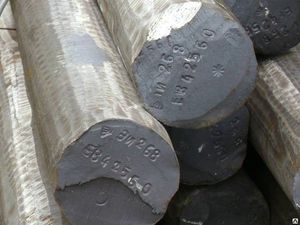 It is the carbon content in steel, as well as the name and amount of alloying additives introduced into its composition, that are most interesting for analyzing the resulting properties of a particular grade.
It is the carbon content in steel, as well as the name and amount of alloying additives introduced into its composition, that are most interesting for analyzing the resulting properties of a particular grade.
In the first place in importance is carbon, because steel is alloy of iron and carbon. An increase in carbon content leads to an increase in strength with a simultaneous decrease in ductility. It also determines the processability of steel (cutting, weldability, forming).
Alloying elements are introduced in the required proportions, depending on the need to obtain certain properties. Each element has its own characteristics. For example, chromium improves mechanical properties, nickel lowers the cold brittleness threshold, tungsten and molybdenum increase the heat resistance of a quick cutter, etc.
Russian steel marking system
There is no unified steel marking system on the world metal market. In parallel, there are Russian, European , American and Japanese systems. The lack of a single standard introduces certain difficulties in international trade transactions.
In our country, an alphanumeric system has been adopted. In it, letters correspond to various elements, and numbers indicate the content of the corresponding elements. In Germany, a system similar in principle to the Russian one is also sometimes used.
The alphanumeric system has a huge advantage over others, as it allows not only to distinguish one steel grade from another, but also to judge technological and structural characteristics by a set of letters and numbers.
The domestic system also applies some special notations:
- Steels of ordinary quality are indicated by the index "St", followed by the grade number. Before it, a group of guaranteed properties (mechanical, chemical composition) can be indicated.
- Structural high-quality carbon steels are designated by hundredths of a percentage of carbon and marked by the degree of deoxidation (for example, 08KP).
- High-quality carbon tool steels are designated by the index "U", followed by the carbon content in tenths of a percent (for example, U8).
- High-speed steels are designated by the index "P", followed by the percentage of tungsten (for example, P18).
The marking of alloyed steels is very informative: the corresponding letters of the Russian alphabet are used to designate alloying elements: “X” - chromium, “H” - nickel, “T” - titanium, “M” - molybdenum, “Yu” - aluminum, “V” - tungsten, etc.
When marking structural alloyed steels, at the very beginning, the carbon content is indicated in hundredths of a percent, and when marking tool alloyed steels, in tenths of a percent.
Steel 12X18H10T
Consider from a position Russian system marking composition and properties of one of the most popular stainless steel 12X18H10T. Decryption is not difficult:
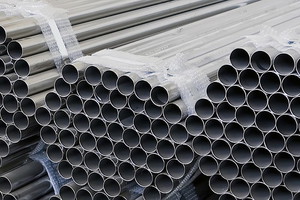
Only the main alloying elements are indicated in the marking. The full chemical composition for any grade is given in steel grades. From there you can also get information about the properties of steel.
After analyzing the composition of 12X18H10T, using in-depth knowledge of the effect of alloying additives, we can conclude that given steel:
- can be used for products operating in aggressive environments;
- has high resistance to electrochemical corrosion;
- suitable for lightly loaded parts in chemically active environments;
- can be used for loaded parts operating for a long time at temperatures up to 600 degrees.
In practice, 12X18H10T is often used for welded equipment, furnace parts and heating systems. The high performance characteristics of this steel allow it to be used in a large number of industries where increased corrosion resistance.
By analogy with the considered example of 12X18H10T steel, using the high information content of the domestic marking system and knowledge of the influence of alloying elements, it is possible to draw a conclusion about its characteristics for any grade.
Any specialist dealing with metal is familiar with the concept of "steel grade". Deciphering the marking of steel alloys makes it possible to get an idea of their chemical composition and physical characteristics. Understanding this marking, despite its apparent complexity, is quite simple - it is only important to know on what basis it is compiled.
They designate the alloy with letters and numbers, by which you can accurately determine which chemical elements it contains and in what quantity. Knowing this, as well as how each of these elements can affect the finished alloy, you can a high degree probabilities to determine which specifications characteristic of a particular steel grade.
Types of steels and features of their marking
Steel is an alloy of iron with carbon, while the content of the latter in it is not more than 2.14%. Carbon gives the alloy hardness, but when it is in excess, the metal becomes too brittle.
One of the most important parameters according to which steels are divided into different classes is the chemical composition. Among steels according to this criterion, alloyed and carbon steels are distinguished, the latter are divided into low-carbon (up to 0.25%), medium-(0.25–0.6%) and high-carbon (they contain more than 0.6% carbon).
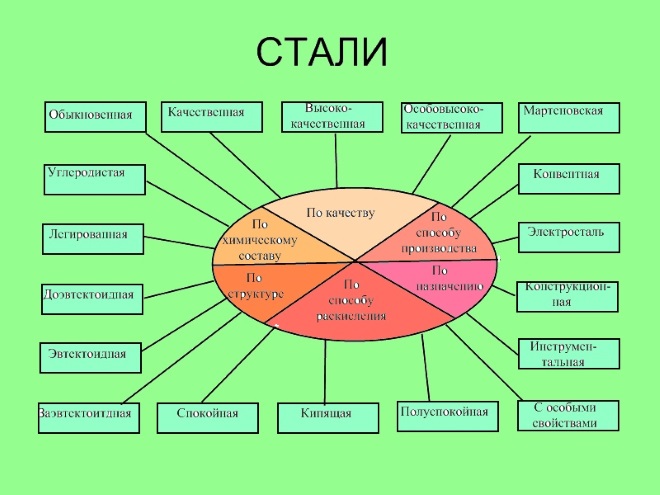
By including alloying elements in the composition of steel, it can be given the required characteristics. It is in this way, by combining the type and quantitative content of additives, that grades with improved mechanical properties, corrosion resistance, magnetic and electrical characteristics are obtained. Of course, it is possible to improve the characteristics of steels with the help of heat treatment, but alloying additives make it possible to do this more efficiently.
According to the quantitative composition of alloying elements, low-, medium- and high-alloyed alloys are distinguished. In the first alloying elements, no more than 2.5%, in medium-alloyed - 2.5-10%, in high-alloyed - more than 10%.
The classification of steels is also carried out according to their purpose. So, there are instrumental and structural types, brands that differ in special physical properties. Tool types are used for the production of stamping, measuring, and cutting tools, structural - for the production of products used in construction and engineering. From alloys with special physical properties (also called precision alloys), products are made that must have special characteristics (magnetic, strength, etc.).

Steels are opposed to each other by special chemical properties. The alloys of this group include stainless, scale-resistant, heat-resistant, etc. What is typical, stainless steels can be corrosion resistant and are different categories.
In addition to useful elements, steel also includes harmful impurities, the main of which are sulfur and phosphorus. It also contains gases in an unbound state (oxygen and nitrogen), which negatively affects its characteristics.
If we consider the main harmful impurities, then phosphorus increases the brittleness of the alloy, which is especially pronounced at low temperatures (the so-called cold brittleness), and sulfur causes cracks in the metal heated to high temperature(red brittleness). Phosphorus, among other things, significantly reduces the ductility of the heated metal. According to the quantitative content of these two elements, steels of ordinary quality (not more than 0.06–0.07% sulfur and phosphorus), high-quality (up to 0.035%), high-quality (up to 0.025%) and especially high-quality (sulfur - up to 0.015%, phosphorus - up to 0.02%).
The marking of steels also indicates the extent to which oxygen has been removed from their composition. According to the level of deoxidation, steels are distinguished:
- calm type, denoted by the letter combination "SP";
- semi-calm - "PS";
- boiling - "KP".
What does steel marking say?
Deciphering the brand of steel is quite simple, you only need to have certain information. Structural steels of ordinary quality and not containing alloying elements are marked with the letter combination "St". By the number after the letters in the brand name, you can determine how much carbon is in such an alloy (calculated in tenths of a percent). The letters “KP” may follow the numbers: it becomes clear from them that this alloy has not completely gone through the process of deoxidation in the furnace, respectively, it belongs to the boiling category. If the brand name does not contain such letters, then the steel corresponds to the calm category.
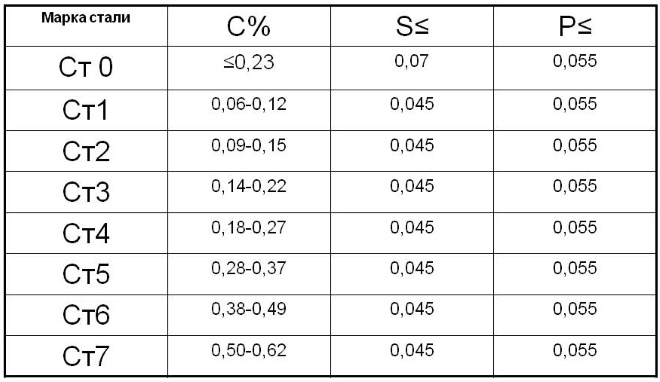
Structural, belonging to the category of quality, has two digits in its designation, they determine the average carbon content in it (calculated in hundredths of a percent).
Before proceeding to consider the grades of those steels that include alloying additives, you should understand how these additives are designated. Marking of alloy steels may include the following letters:

Designation of steels with alloying elements
As mentioned above, the classification of steels with alloying elements includes several categories. The marking of alloy steels is compiled according to certain rules, the knowledge of which makes it quite easy to determine the category of a particular alloy and its main area of application. In the initial part of the names of such brands there are numbers (two or one) indicating the carbon content. Two numbers indicate its average content in the alloy in hundredths of a percent, and one - in tenths. There are also steels that do not have numbers at the beginning of the brand name. This means that carbon in these alloys is contained within 1%.

The letters that can be seen behind the first digits of the brand name indicate what this alloy consists of. Behind the letters, giving information about a particular element in its composition, there may or may not be numbers. If there is a number, then it determines (in whole percent) the average content of the element indicated by the letter in the composition of the alloy, and if there is no number, then this element is contained in the range from 1 to 1.5%.
At the end of the marking of certain types of steels, the letter "A" may be placed. This suggests that we have high-quality steel. Such grades may include carbon steels and alloys with alloying additives in their composition. According to the classification, this category of steels includes those in which sulfur and phosphorus make up no more than 0.03%.
Examples of marking steels of various types
Determining the grade of steel and assigning an alloy to a certain type is a task that should not cause any problems for a specialist. There is not always a table at hand that gives a breakdown of the brand names, but the examples below will help you figure it out.
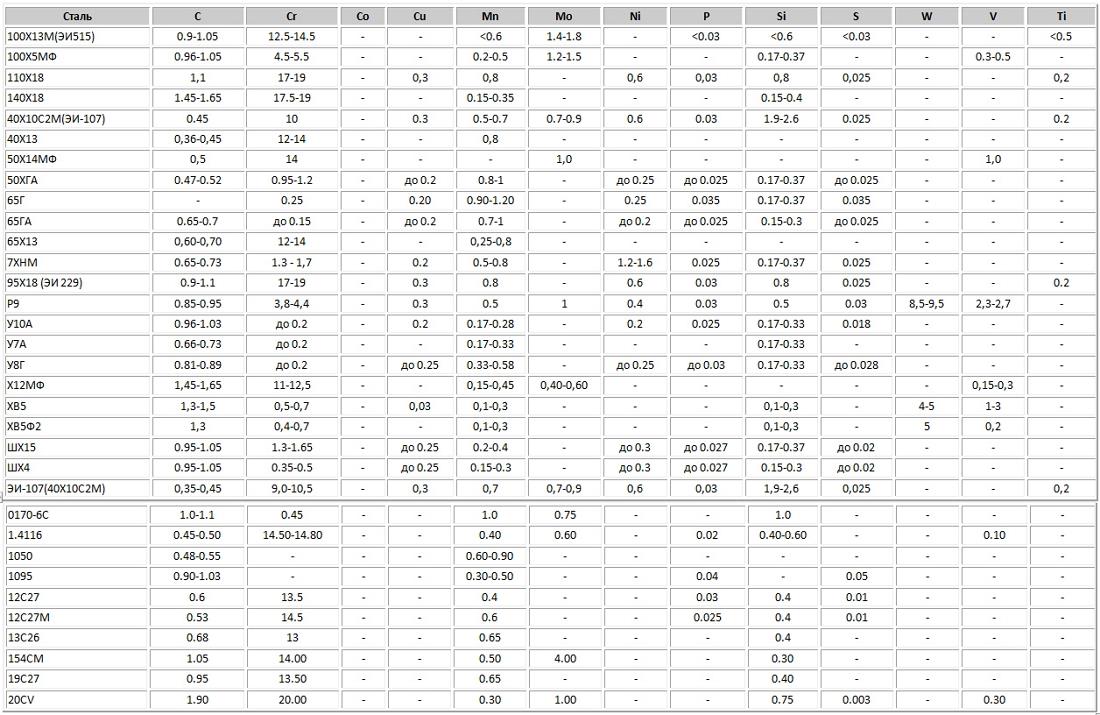
Structural steels that do not contain alloying elements are designated by the letter combination "St". The numbers following are the carbon content, calculated in hundredths of a percent. Low-alloy structural steels are marked somewhat differently. For example, steel grade 09G2S contains 0.09% carbon, and alloying additives (manganese, silicon, etc.) are contained in it within 2.5%. Very similar in their markings, 10KhSND and 15KhSND differ in different amounts of carbon, and the share of each alloying element in them is no more than 1%. That is why there are no numbers after the letters denoting each alloying element in such an alloy.
20X, 30X, 40X, etc. - this is how structural alloyed steels are marked, the predominant alloying element in them is chromium. The number at the beginning of such a brand is the carbon content in the alloy in question, calculated in hundredths of a percent. Behind the letter designation of each alloying element, a number can be affixed, by which its quantitative content in the alloy is determined. If it is not there, then the specified element in the steel contains no more than 1.5%.
You can consider an example of the designation of chromium-silicon-manganese steel 30KhGSA. It, according to the marking, consists of carbon (0.3%), manganese, silicon, and chromium. Each of these elements is contained in it within the boundaries of 0.8–1.1%.
How to decipher steel markings?
To decipher the notation various kinds steels did not cause difficulties, you should know well what they are. Separate categories of steels have a special marking. It is customary to designate them with certain letters, which allows you to immediately understand both the purpose of the metal in question and its approximate composition. Consider some of these brands and understand their designation.

Structural steels specially designed for the manufacture of bearings can be recognized by the letter "Ш", this letter is placed at the very beginning of their marking. After it in the brand name comes the letter designation of the corresponding alloying additives, as well as numbers by which the quantitative content of these additives is recognized. So, in steel grades ШХ4 and ШХ15, in addition to iron with carbon, chromium is contained in an amount of 0.4 and 1.5%, respectively.
The letter "K", which comes after the first digits in the name of the brand, reporting the quantitative content of carbon, denotes structural unalloyed steels used for the production of vessels and steam boilers operating under high pressure(20K, 22K, etc.).
High-quality alloy steels that have improved casting properties can be recognized by the letter "L" at the very end of the marking (35KhML, 40KhL, etc.).
Some difficulty, if you do not know the features of the marking, can be caused by deciphering the grades of building steel. Alloys of this category are designated by the letter "C", which is placed at the very beginning. The numbers following it indicate the minimum yield strength. These stamps also use additional letter designations:
- letter T - heat-strengthened rolled products;
- the letter K - steel, characterized by increased corrosion resistance;
- letter D - an alloy characterized by a high content of copper (C345T, C390K, etc.).
Unalloyed steels belonging to the category of tool steels are designated by the letter "U", it is affixed at the beginning of their marking. The number following this letter expresses the quantitative content of carbon in the alloy in question. Steels of this category can be high-quality and high-quality (they can be identified by the letter "A", it is affixed at the end of the brand name). Their marking may contain the letter "G", which means an increased content of manganese (U7, U8, U8A, U8GA, etc.).

The marking of those steels that are included in the category of high-speed cutting begins with the letter "P", followed by numbers indicating the quantitative content of tungsten. Otherwise, the grades of such alloys are named according to the standard principle: letters denoting the element, and, accordingly, numbers reflecting its quantitative content. In the designation of such steels, chromium is not indicated, since its standard content in them is about 4%, as well as carbon, the amount of which is proportional to the content of vanadium. If the amount of vanadium exceeds 2.5%, then its letter designation and quantitative content are put down at the very end of the marking (Z9, R18, R6M5F3, etc.).
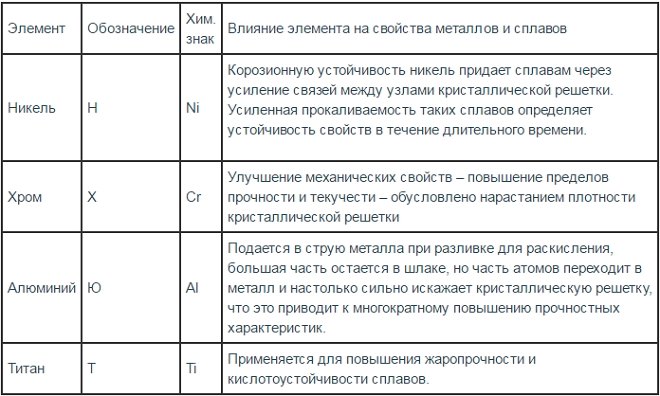
Unalloyed steels belonging to the category of electrical engineering are marked in a special way (they are also often called pure technical iron). The low electrical resistance of such metals is ensured due to the fact that their composition is characterized by a minimum carbon content - less than 0.04%. There are no letters in the designation of the grades of such steels, only numbers: 10880, 20880, etc. The first digit indicates the classification according to the type of processing: hot-rolled or forged - 1, calibrated - 2. The second digit is associated with the category of the aging coefficient: 0 - non-standardized, 1 - normalized. The third digit indicates the group to which this steel belongs according to the normalized characteristic, taken as the main one. The value of the normalized characteristic is determined by the fourth and fifth digits.
Processed materials
At present, it is no secret to anyone that various products are manufactured at machine-building enterprises from various materials, steels and alloys.
Materials, in turn, are divided into structural and instrumental.
Construction materials
metal- these include alloys based on iron, copper, nickel, aluminum, magnesium, titanium and other metals.
Non metal- These include various plastics, ceramics, glass, rubber and other materials.
Composite- these materials combine dissimilar materials, and the properties of the fillers are fundamentally different from the composite material.
In mechanical engineering, metals in their pure form are rarely used, mainly metal alloys are of great use. For this purpose, symbols for grades of engineering materials have been created, they include symbols and it is possible to determine or decipher grades of alloys from them.
Conventions metal elements in alloys
| Element | Ferrous alloys | Non-ferrous alloys |
| Aluminum | YU | BUT |
| Barium | - | Br |
| beryllium | L | - |
| Bor | R | - |
| Vanadium | F | To you |
| Tungsten | IN | - |
| Galiy | Guy | - |
| Germanium | - | G |
| Europium | - | Ev |
| Iron | - | F |
| Gold | - | Ying |
| Iridium | - | AND |
| Cadmium | cd | cd |
| Cobalt | TO | TO |
| Silicon | FROM | Cr (K) |
| Lithium | - | Lay |
| Magnesium | W | Mg |
| Manganese | G | Mts (Mr) |
| Copper | D | M |
| Molybdenum | M | - |
| Nickel | H | H |
| Niobium | B | Np |
| Tin | - | ABOUT |
| Osmium | - | os |
| Palladium | - | Pd |
| Platinum | - | Pl |
| Rhenium | - | Re |
| Rhodium | - | Rg |
| Mercury | - | R |
| Ruthenium | - | RU |
| Lead | - | FROM |
| Silver | - | Wed |
| Scandium | - | scm |
| Antimony | - | Su |
| Thallium | - | Tl |
| Tantalum | - | TT |
| Titanium | T | TPD |
| Carbon | At | - |
| Phosphorus | P | F |
| Chromium | X | X (Xp) |
| Cerium | - | Se |
| Zinc | - | C |
| Zirconium | C | CEV |
| Erbium | - | Erm |
| Bismuth | In and | In and |
Cast iron- it is an alloy of iron, carbon, as well as additives of silicon, manganese and other substances, and the carbon content is 2.14 ... 4.5%. There are several types of cast iron: gray cast iron is marked SCh, and malleable cast iron KCh.
Steel is an alloy of iron and carbon, with a carbon content of up to 2%.
Deciphering the brand of alloys
Based on the table, you can decipher the grade of the alloy, for example:
Let's take the most common stainless steel:
12X18H10T
Carbon up to 1%
Chrome 18%
Nickel 10%
Titanium up to 1%
The rest of the iron
The first numbers (they may not be) show the percentage of carbon, do not forget the carbon in alloys up to 1%, that is, if the number is 09 or 12, this means that carbon is up to 1% in hundredths of a percent 0.09 and 0.12. The numbers following the letters mean the percentage of additives, if the number is not there, then the% content is 1%. Let's try to decipher aluminum alloy:
AMG6
Carbon up to 1%
Aluminum 1%
Molybdenum 1%
Manganese 6%
The rest is iron.
Symbols of grades of materials
Cast iron with ductile graphite (gray cast iron) GOST 1412-85: Designated by the letters SCh and numbers that indicate the ultimate tensile strength (SCH20).
Nodular cast iron (ductile iron) GOST 7293-85: Indicated by the letters HF and numbers indicating the ultimate tensile strength (HF 45).
malleable iron GOST 1215-79**: Denoted by letters КЧ. The first number indicates the tensile strength, the second number is the relative elongation in percent (KN 30-6).
Cast iron alloyed with special properties heat resistance, wear resistance, heat-resistant GOST 7769-82 **: Designated with the letter H, subsequent letters indicate the presence of alloying elements, and the numbers following them indicate the corresponding percentage of these elements. The last letter Sh indicates that cast iron with nodular graphite (ChS5Sh).
Regular quality carbon steel GOST 380-94: Indicated by the letters St and numbers from 0 to 6. The higher the number, the greater the carbon content and tensile strength (St1, St2 ... St6). The degree of steel deoxidation is indicated by letters after the numbers, for example: kp - boiling, ps - semi-calm, SP - calm.
Carbon steel quality structural GOST 1050-88**: Denoted by two numbers: 05, 08, 10, 11, 15, 18, 20, 25, 30, 35, 40, 45, 50, 55, 60 showing the average carbon content in hundredths of a percent. The letters ps and kp after the numbers mean semi-calm and boiling steel.
Low alloy structural steel GOST 19281-89**: the first two digits indicate the carbon content in hundredths.
Alloy structural steel GOST 4543-71*: letters after numbers indicate the presence of alloying elements as a percentage (35G2, 20N2M). If the content of alloying elements is less than 1.5%, then the figure is not set (50XA, 15XM). The letters A, W at the end of the designation indicate that the steel is high-quality (15ХА, 20ХН3А) and especially high-quality.
Carbon tool steel GOST 1435-90: denoted by the letter U and numbers that indicate the carbon content in tenths of a percent (U7, U8, U10). The letter A after the number means that the steel is high-quality (U8A).
Alloy tool steel GOST 5950-73*: the first digits indicate the carbon content in tenths of a percent if it is more than 0.1% (9X1, 9XC). The numbers after the letters indicate the alloying element and its percentage (X12, 8X3).
Bearing steel GOST 801-78 *: denoted by the letters ШХ and numbers showing the chromium content in tenths of a percent, and the letters after the numbers indicate the presence of alloying elements (ШХ15СГ).
Aluminum alloys
Foundry GOST 2685-75: are designated by the letters AL, after which the alloy number (AL2) is indicated.
Deformable GOST 4784-74 *: denoted by the letters D, AK, AN, VD, after which the alloy number (D16) is indicated.
magnesium alloys
Foundry GOST 2856-79 *: indicated by the letters Ml, after which the alloy number (Ml5) is indicated.
Deformable GOST 14957-76 *: denoted by the letters MA, after which the alloy number is indicated.
Brass
Processed by pressure GOST 15527-70 *, Foundry GOST 17711-80: denoted by the letter L. Subsequent letters indicate alloying elements. The first number indicates the copper content in percent, the rest correspond to the sequence of letters, the content of alloying elements in percent (LMtsS58-2-2).
Foundry bronzes
Tinless GOST 493-79, tin GOST 613-79: denoted by the letters Br, subsequent letters indicate alloying elements, and the numbers indicate their percentage (BrO4-4).
Steel marking - what do the letters mean?
There are really a lot of signs of steels by which they are classified, and it is not always possible to figure out how steel is marked and how its properties can be understood from the marking. However, there is nothing complicated about this. First you need to imagine the classification of steels, at least briefly - how steels are divided, according to what criteria they are divided.
Ordinary alloys of iron and carbon are called carbon and fall into subgroups - low-carbon, medium-carbon and high-carbon. Carbon reduces the ductility and flexibility of steel, but adds strength to it. Its share, respectively, is up to 0.25%, from 0.25% to 0.6% and from 0.6% to 2% (above 2% is no longer steel, but cast iron).
Alloys, where other elements are also involved, are called alloyed, and these additional elements are called alloying. In the case of high-alloy steel, the additives in it are more than 10%, for low-alloy steel - up to 2.5%. Between these numbers is the medium-alloyed species.
MORE ABOUT VARIETIES OF STEEL
The functional purpose is the basis from which the labeling begins. GOST prescribes that steel be divided separately into those that are suitable for the purposes of construction and engineering, namely the production of parts in this industry (this type is called structural), as well as those that are used for the manufacture of steel tools (respectively, tool). There is also a whole group of materials that are designed to give them some specialized physical features, such as steels designed to pass an electromagnetic field through them, or stainless steels, among which are corrosion resistant and those that can withstand five thousand degrees Celsius.
Steel, like any other product, is also divided according to quality, which also leaves its mark on their marking. When steel is smelted, small amounts of sulfur and phosphorus can remain in it - additives with which steel loses all its beneficial features becoming brittle under various processing conditions. The quality of steel varies from ordinary steel to high quality, then high quality and extra high quality. The percentage of sulfur contained in them, respectively, up to 0.06, up to 0.04, up to 0.03 and up to 0.015; percentage of phosphorus up to 0.07, up to 0.035, up to 0.03 and up to 0.025. The smaller, the higher the quality of the steel.
IN Russian Federation They are named with letters and numbers. The elements of the alloy and the degree of deoxidation, that is, how much oxygen is removed from the steel, are indicated by letters. The numbers show the amount of chemical components present in the composition of the alloy.
The indicator of how much the steel is deoxidized is very important for predicting its properties based on the marking. According to the level of deoxidation, there are three types of steel:
- Boiling (they are designated as KP);
- Semi-calm, that is, oxygen is not completely removed (PS);
- Calm anoxic (labeled as SP).
ORDINARY QUALITY
Let's try to decipher, for example, the VSt4SP marking.
On steel of ordinary quality they write "St". The next number is the brand. The higher it is, the more carbon - that is, the stronger the steel. Before "St" there is a letter - this means that the steel accurately retains some characteristics. There are three types of them - guaranteed mechanical properties, Chemical properties, or a guarantee of both properties. They are denoted by the letters A, B, C, the first is often omitted. The last characters are a familiar indicator of deoxidation.
This means that the decoding of our abbreviation will sound like this: steel of ordinary quality grade 4, completely deoxidized, in which mechanical and chemical properties are guaranteed.
CARBON QUALITY STEELS
Let's practice and decipher, for example, such abbreviations: 07KP and U9A.
High-quality steel, depending on the purpose, is marked differently. It does not contain the "St" index. So, the number at the beginning of the marking of structural steels indicates hundredths of C. Two letters behind it - the content of O.
Instrumental ones are recognized by the initial letter "U", immediately after it - the content of C in hundredths. Higher quality steels are indicated by the letter "A" or "W" at the end, depending on whether the steel is high quality or extra high quality.
This means that the decoding will be as follows: 07KP is a high-quality structural boiling steel with a carbon content of 0.07%, and U9A is a high-quality tool steel, in which carbon is 0.09%.
DESIGNATION OF ALLOYING COMPONENTS
A number of letters are used to designate the components of steel that give it the desired properties. We will not consider in detail all types of additives and all letters - there are many of them and they can be found in the reference book. We will just briefly touch on how to decipher such abbreviations as 10X14G14N4T.
The first two digits indicate the percentage of carbon in hundredths. If they are not there, we must conclude that we are dealing with tool steel, and the level C in it does not exceed one and a half percent. Further, the letters that indicate the corresponding additive, and the numbers that tell us about its percentage in the composition of the alloy. If there is no number, the additives in the alloy are from 0.8 to one and a half percent.
What does 10X14G14N4T tell us about? Alloy steel, carbon content 0.1%, chromium 14%, manganese 14%, nickel 4%, titanium 0.8-1.5%.
SPECIAL STEELS
Separately, one should touch on such designations as ShKh15SG, R9M4K8 or ATs45G2.
ShKh is ball-bearing steel. After the letter X, the chromium content is indicated. So, ШХ15СГ means ball-bearing steel with 1.5% chromium content and from 0.8% to 1.5% silicon and manganese.
A - automatic (that is, one that is suitable for processing on automatic machines). The numbers after this letter indicate the amount of carbon (if there are none, then carbon is not more than 1.5%), in our case we have automatic steel containing up to one and a half hundredths of carbon, 45% zirconium and 2% manganese.
The symbol "P" marks high-speed steel. The next figure is the percentage of tungsten. Let's decipher our abbreviation, having received high-speed steel with a content of 9% tungsten, 4% molybdenum and 8% cobalt.
CUSTOM STEEL
Steel smelted for experimental purposes is usually coded as follows: the index of the plant that smelted it, then the serial number. Among the indices there are, for example, the following: "EP" - Elektrostal, or "DI" - Dneprospetsstal.
In addition, the letters may indicate the manner in which the steel was smelted. The letters, say, "VI" in this case indicate that the steel was smelted using the vacuum induction method.
